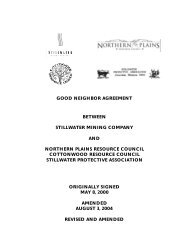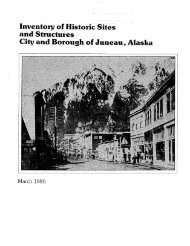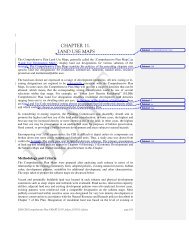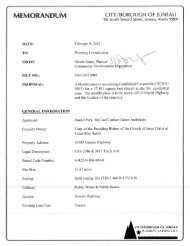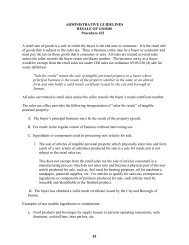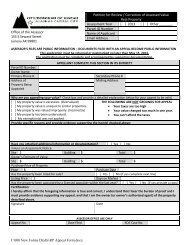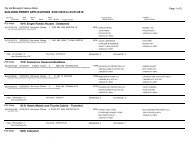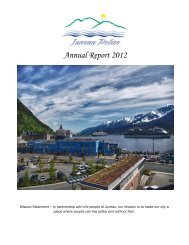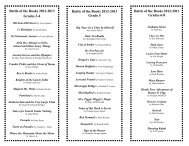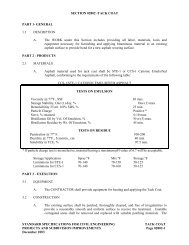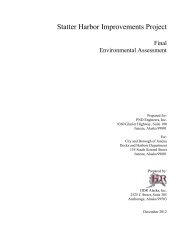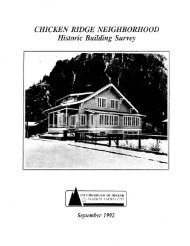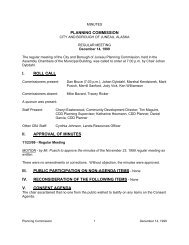Sanitary Sewer Pipe - City and Borough of Juneau
Sanitary Sewer Pipe - City and Borough of Juneau
Sanitary Sewer Pipe - City and Borough of Juneau
You also want an ePaper? Increase the reach of your titles
YUMPU automatically turns print PDFs into web optimized ePapers that Google loves.
SECTION 02401 - SANITARY SEWER PIPE<br />
service wyes can be installed in the proper location as the mainline pipe is being installed.<br />
No service saddles will be permitted, unless approved by the ENGINEER.<br />
P. Where gravity flow sanitary sewers cross above or less than 18 inches below waterlines,<br />
or approximately parallel water lines within ten feet horizontally, the sewer pipe shall<br />
meet the requirements <strong>of</strong> ductile iron pipe or PVC pressure pipe, as described in Part 2 <strong>of</strong><br />
this Section.<br />
Q. HDPE to HDPE connections shall be made by thermal butt fusion, in accordance with<br />
ASTM D2657. Fusion jointing shall utilize a pipe manufacturer approved fusion<br />
machine operated by experienced <strong>and</strong> qualified personnel. The CONTRACTOR shall<br />
provide three copies <strong>of</strong> a "Heat Fusion Qualification Guide," published by the HDPE<br />
manufacturer, that provides criteria for inspection <strong>of</strong> thermal fusion joints. The guide<br />
shall include criteria for operator training requirements <strong>and</strong> experience; visual inspection<br />
criteria (including photographs) for both intact thermal fusion joints <strong>and</strong> sample strips cut<br />
for thermal fusion joints. The thermal fusion machine operator shall perform a minimum<br />
<strong>of</strong> three test joints in the presence <strong>of</strong> the ENGINEER. The test joints will be examined<br />
from both exterior appearances <strong>and</strong> from appearance <strong>of</strong> the joint cross section once the<br />
samples have been cut into strips.<br />
R. Bolted HDPE to HDPE connections shall include a polyethylene flange adapter (stub<br />
end) butt fused to the pipe, a backup flange ring, bolts, nuts <strong>and</strong> a gasket. Flange rings<br />
shall be St<strong>and</strong>ard Steel ring Flanges, Class D, in accordance with AWWA C207. High<br />
strength bolts, nuts, washers <strong>and</strong> gaskets shall be in conformance with AWWA C207,<br />
Appendix A. Flange rings, bolts, nuts <strong>and</strong> washers shall be hot dip galvanized after<br />
fabrication per ASTM A153 <strong>and</strong> A386. Gasket dimensions <strong>and</strong> bolt lengths shall be per<br />
pipe manufacturer's recommendations.<br />
3.2 TESTING<br />
A. Prior to testing all manholes, all sections <strong>of</strong> pipe shall be cleaned using an inflatable<br />
rubber ball <strong>of</strong> a size that will inflate to fit snugly into the pipe. The ball may, at the<br />
option <strong>of</strong> the CONTRACTOR, be used without a tag line; or a rope or cord may be<br />
fastened to the ball to enable the CONTRACTOR to know <strong>and</strong> control its position at all<br />
times. The ball shall be placed in the last clean out or manhole on the pipe to be cleaned,<br />
<strong>and</strong> water shall be introduced behind it. The ball shall pass through the pipe with only<br />
the force <strong>of</strong> the water impelling it. All debris flushed out ahead <strong>of</strong> the ball shall be<br />
removed at the first manhole where its presence is noted. In the event cemented or<br />
wedged debris, or a damaged pipe, stops the ball, the CONTRACTOR shall remove the<br />
obstruction <strong>and</strong> make any necessary repairs in a manner that is acceptable to the<br />
ENGINEER. Any alternate methods <strong>of</strong> cleaning sewers shall be submitted to the<br />
ENGINEER for approval, <strong>and</strong> shall not be used unless approved.<br />
B. Prior to testing, the sewer shall be complete with laterals, <strong>and</strong> trenches shall be fully<br />
backfilled <strong>and</strong> compacted to finish grade, or, if the sewer is under pavement, finish<br />
pavement subgrade.<br />
C. For WORK involving placement <strong>of</strong> new sanitary sewer collection systems, all sections <strong>of</strong><br />
pipe shall be tested for leakage using the Exfiltration Test for either air or water as<br />
specified hereafter; or, at the sole direction <strong>of</strong> the ENGINEER, when the normal water<br />
STANDARD SPECIFICATIONS FOR CIVIL ENGINEERING SANITARY SEWER PIPE<br />
PROJECTS AND SUBDIVISION IMPROVEMENTS Page 02401-6<br />
December 2003



